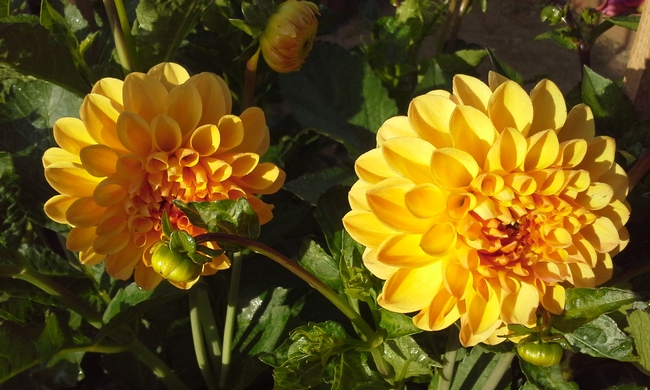
Named for botanist Anders Dahl, the dahlia is the official flower of San Francisco and also of Mexico. It is a perennial plant that can stand alone or serve as filler around shrubs, as a colorful border or as a bright spot in pots.
Dahlias bloom from midsummer until winter's first frost. They have strong stems, divided leaves and blooms that range from 10 inches across for the so-called "dinner plate" types to the smallest lollypop-style pompons. Some grow almost five feet tall.
Dahlias can thrive in full sun but need some shade in the hottest areas. The plants require at least 120 days to bloom, and they do well in the cool, moist Pacific Coast climate.They prefer regular watering and rich, loose, well-drained soil that is slightly acidic.
When planting dahlias, be patient. Wait until after the last frost and until soil temperature reaches 60°F. Choose an area protected from wind that gets six to eight hours of direct sun every day, predominantly morning sun.
Make sure all your tubers are firm and healthy looking. Some tubers may have a little green shoot, which is a good sign.
Space dahlia tubers one to three feet apart, with the wider spacing for taller varieties.
Dig a planting hole larger than the tuber. Incorporate compost and a sprinkle of bone meal. Plant the tubers four to six inches deep with the points, or “eyes,” facing up.
Larger plants will require staking. Stake them at planting time so you will not accidentally injure a tuber when sinking the supports later. Tie a flag or something at the top of each stake. Urban legends abound about gardeners bending over and poking an eye on a stake.
Tie plants to the stakes as they grow. Wait until the first green shoot breaches the soil before watering. Avoid covering with mulch or bark as this may deter sprouting and encourage slugs and snails.
The larger dahlia blooms look best in a dedicated area, but smaller varieties work well as add-ins just about anywhere. I like to plant them randomly in my garden for a burst of color.
When the first shoots appear, start watering deeply two to three times a week. Use a low-nitrogen fertilizer to avoid ranginess and a decrease in flower production. Dahlias should bloom in about eight weeks. The larger blooms will need staking but the smaller varieties just need pinching to keep them bushy. If you pinch and deadhead regularly, you will get a wonderful flower display for about three months.
In our areas, gardeners differ on whether to leave dahlias in the ground over the winter or to dig them up and store them. If you choose to store the tubers, clean off all soil and put each tuber in a separate brown paper bag in a cool dry location. Separating them helps prevent any transfer of disease or mildew. If you choose to leave them in the ground, cover them with a deep, dry mulch. The foliage turns black after a frost and should be cut back to the ground.
Dahlias are relatively pest resistant although slugs and snails find them tasty. Aphids and powdery mildew can be a problem. Check the University of California's Integrated Pest Management website for more information on growing dahlias.
Workshop: Napa County Master Gardeners are offering a workshop titled “More on Flowers” on Sunday, May 31, from 2 p.m. to 4 p.m., at Yountville Community Center, 6516 Washington Street, Yountville. Learn how to use flowers as focal points in the garden and how to care for them to keep them looking great. To register, contact the Parks and Recreation Department at 707-944-8712 or visit itsweb site.
Master Gardeners are volunteers who help the University of California reach the gardening public with home gardening information. Napa County Master Gardeners ( http://ucanr.org/ucmgnapa/) are available to answer gardening questions in person or by phone, Monday, Wednesday and Friday, 9 a.m. to Noon, at the U. C. Cooperative Extension office, 1710 Soscol Avenue, Suite 4, Napa, 707-253-4143, or from outside City of Napa toll-free at 877-279-3065. Or e-mail your garden questions by following the guidelines on our web site. Click on Napa, then on Have Garden Questions? Find us on Facebook under UC Master Gardeners of Napa County.
Attached Images:

